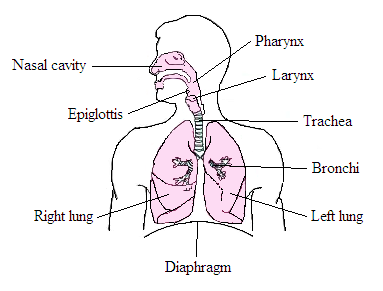
The respiratory system is the basic element of the transport system (Fig. 22).
Figure 22 Structure of the respiratory system

The structure of the respiratory system
The respiratory system is composed of the respiratory pathways or airways and the lungs which are its central organ. The air is inhaled into the system through the nose and the nasal cavity. It further progresses into the larynx and trachea (windpipe) later branching into two bronchi (sg. bronchus) that enter the lungs and split into bronchioles. Subsequently the air finally reaches the alveoli which are blood-perfused thin-walled air sacs. This is where the oxygen is transported into the blood.
Breathing may be divided into two main stages: inspiration and expiration. Breathing is a muscular activity. In inspiration breathing muscles are employed, on inspiration the diaphragm contracts and moves down and the intercostal muscles push the ribs up which lifts the rib cage and creates space for the enlarged lungs. Inspiration is facilitated through pressure changes inside the pleural cavity.
On expiration breathing muscles relax, ribs move down and the chest space decreases.
Physiological parameters of the breathing system
The breathing frequency (BF) = a number of inspirations per minute, given in breaths per minute.
Tidal volume (VT) = the volume of air exhaled in one expiration or inspiration, given in litres.
Ventilation (VE)= the volume of air inhaled (inhaled minute volume) or exhaled (exhaled minute volume) from a person's lungs, given in litres per minute.
Vital capacity (VC) = the maximum amount of air a person can expel from the lungs after a maximum inspiration, given in litres.
Oxygen uptake (VO2) = volume of oxygen received by an organism per minute, given in ml/min/kg. VO2 max = maximum oxygen uptake.
Carbon-dioxide production (VCO2) = volume of the exhaled CO2 per minute, given in ml/min/kg.
Respiratory exchange ratio (RER), respiratory quotient (RQ) = the ratio of the exhaled CO2 to the inhaled O2.
The ventilation equivalent for oxygen (VE, VO2) = volume of oxygen inhaled from one litre of the air.
Oxygen pulse (VO2/HR) = volume of oxygen transported into the blood circulation during one heart contraction.
Response and adaptation of the respiratory system to workload
Breathing frequency
The values of resting breathing frequency in the average population stand at about 16 breaths per minute.
Response: Under workload the BF values increase depending on the workload intensity. Maximum values are in the region of 40 breaths per minute.
Adaptation: The increased volume of the lungs, i.e. the increase in the breathing volume in the trained individuals results in the decrease in the BF resting values which may be under 10 breaths per minute. The maximum values can be as 60 breaths per minute high.
Tidal volume
The VT values in the average population are around 0.5 l.
Response: Under workload the VT values tend to rise up to the level of 2.5 litres.
Adaptation: In some endurance-trained individuals there occurs an increase in the resting VT values of up to 1 litre or more. Under workload the values may reach about 60% of VC, i.e. over 4 litres.
Ventilation
The minute ventilation may be calculated through multiplying the breathing frequency by the tidal volume (VE=BF*VT). Under resting conditions we get the values of around 10 l both in the sporting and non-sporting population.
Response: Under workload the ventilation rises, its maximum values may approach 120 l per min. If the ventilation reaches the level of over 40-50 l, a person will usually breathe with an open mouth.
Adaptation: Physical exercise may increase the ventilation up to the level of 180 l/min.
Vital capacity
The VC is a static parameter. The measured values are affected by a couple of factors: sex, age, body surface, fitness, etc. The average female population reaches the value of about 3-4 litres, in men it is 4-5.5 litres.
Response: The test is not conducted under workload. It is normally carried out after exercise. The low intensity workload may result in the increase of VC values. An individual needs to practise breathing.
Adaptation: Endurance training results in the increase of the VC capacity values which may even exceed the level of 6 litres. The highest values of up to 8 litres have been observed in swimmers. This is caused by exhalation into water which puts up more resistance than the air.
Oxygen uptake (VO2)
The oxygen volume values under resting conditions are about 3.5ml/min/kg.
Response: Rising intensity of workload is accompanied by the growing oxygen intake. The maximum values in women and men reach 35 ml/min/kg and 45 ml/min/kg respectively.
Adaptation: Adaptation to endurance training leads to the increase in maximum values. The values may reach the level of 90 ml/min/kg in world-class cross-country skiers. Endurance training results in the reduction of oxygen intake in various speed zones, the so called economy of running.
Oxygen pulse (VO2/HR)
The resting values are in the region of 5ml.
Response: The maximum values in non-trained individuals are 15-16 ml in men and 10-11 ml in women.
Adaptation: In endurance athletes the pulse oxygen reaches the value of 30-35 ml.